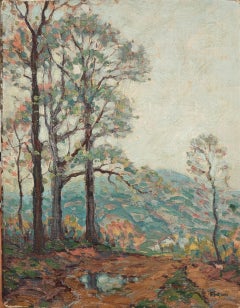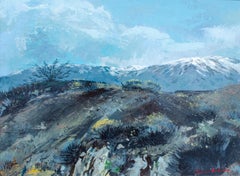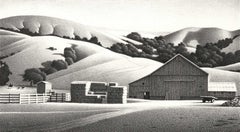Roger Medearis Art
Though he came of age after Regionalism’s heyday in the 1930s, Roger Medearis is a direct connection to the Regionalism of Thomas Hart Benton. Born in Fayette, Missouri, Medearis went to Kansas City at the age of eighteen to study at the Kansas City Art Institute, with the hopes of becoming a commercial illustrator in the manner of Norman Rockwell. Shortly after his arrival, Medearis learned that Benton was an instructor at the Institute, and he soon was a regular in Benton’s classroom. In very short order, Meadearis absorbed every tenet of Benton’s pedagogical exhortations to study the masters of the Renaissance, with particular emphasis on formulating a strong overall design using repeated formal patterns as a structural principle for each painting. Meadearis also absorbed many of Benton’s own techniques as well, producing multi-figure Regionalist works in tempera and oil akin to the works of his master.
Medearis’s ascent in the art world was swift. After two years of schooling under Benton, in the summer of 1940, at the age of twenty, Medearis attempted his first major painting, Breaking Ground at Bethel (formerly in the collection of Himan Brown, New York), a genre painting featuring over twenty figures that depicted the groundbreaking of a country church. Benton was so impressed with this painting that he quickly had it added to an upcoming exhibition of the work of his more senior students to be held at the venerable Associated American Artists gallery in New York. What followed was a decade-long period of activity and sales in the New York art world, and the beginning of a lifelong friendship with Benton. (Medearis later penned a short and charming memoir of his relationship with Benton; see Roger Medearis, “Student of Thomas Hart Benton,” Smithsonian Studies in American Art 4 [Summer–Autumn 1990], pp. 47–61.)
Now under Benton’s wing, Medearis painted a number of striking Regionalist paintings, oftentimes using Benton’s studio. With Benton’s art world connections, Medearis found easy entry into New York galleries (Associated American Artists before World War II, Kende Galleries afterward), where he enjoyed a growing reputation as a notable exponent of Regionalism. When Benton was fired by the Kansas City Art Institute in the spring of 1941 for impertinent remarks about museum administrations, he and Medearis continued to enjoy a happy master-student relationship, with Medearis regularly bringing his paintings to Benton for critiques. After the outbreak of World War II, Medearis left Kansas City for New York in 1942, but he remained close with Benton, the two men keeping in close correspondence and visiting each other regularly. By 1950, however, with abstraction achieving a dominant position in the contemporary art world, Medearis decided to leave behind his career as an artist, and instead became a salesman for Container Corporation of America. Though he was successful in the business world, at Benton’s behest Medearis eventually returned to painting in 1966, though without the same vigor or incisive perception of Midwestern life as he had in his youth.
The subject of Saying Grace, a humorous work that dates from the artist’s student days in Kansas City, is very much in line with the oftentimes cheeky humor of Regionalist painters, who gently send up the lifestyles of their Midwestern subjects for consumption among New York collectors. A review of a 1949 exhibition of Medearis’s work at Kende Galleries, New York, aptly sums up his art:
In condensed form, the prankish scenes of Roger Medearis, on view at the Kende Galleries, are reminiscent of Bruegel, Koerner, and his teacher Thomas Hart Benton. His egg tempera travesties are peopled with good and bad mannered creatures in the best natured sense. They wallow in imagined luxuries or sit straight-jacketed in newly-wedded blisslessness. There seems no end to paintable ideas, no dearth of amusement or lack of straight-forward characterization. Landscapes, houses, folks and animals are all alive in a jolly and luminous world (“Condensed Americana,” The Art Digest 23, April 15, 1949).
Saying Grace is an iconic work by one of Regionalism’s most interesting artists, who until recently was little known because his best works were in private hands. Now that works like this one are coming back into circulation, Roger Medearis’s reputation will likely return to the level he had achieved in the 1940s.
(Biography provided by Hirschl & Adler)
1940s American Modern Roger Medearis Art
Tempera, Board
1940s American Modern Roger Medearis Art
Oil, Board
20th Century American Modern Roger Medearis Art
Oil, Board
Mid-20th Century American Modern Roger Medearis Art
Canvas, Oil, Board
1960s American Modern Roger Medearis Art
Canvas, Oil, Illustration Board
1940s American Modern Roger Medearis Art
Oil, Board
Mid-20th Century American Modern Roger Medearis Art
Oil, Canvas, Board
1930s American Modern Roger Medearis Art
Oil, Board
1940s American Modern Roger Medearis Art
Oil, Board
1930s American Modern Roger Medearis Art
Oil, Board
1940s American Modern Roger Medearis Art
Oil, Board
1940s American Modern Roger Medearis Art
Gouache, Board
1950s American Modern Roger Medearis Art
Canvas, Oil, Cardboard
1990s American Modern Roger Medearis Art
Oil, Panel
1990s American Realist Roger Medearis Art
Lithograph
1970s American Modern Roger Medearis Art
Lithograph




